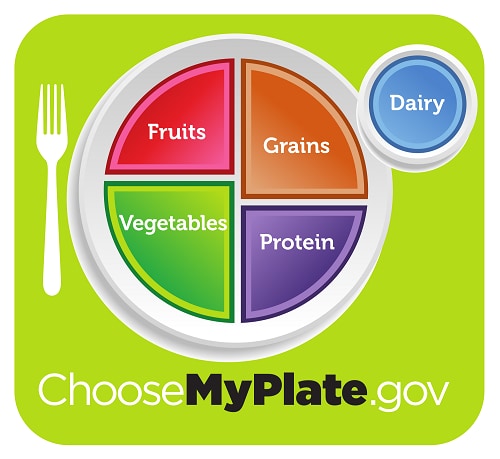At a glance
- Healthy eating in childhood and adolescence promotes growth and development.
- Healthy eating habits can prevent a number of harmful health conditions.
- Healthy eating can help people achieve and maintain a healthy body weight.
- Schools are in a position to offer students the right information to practice healthy eating behaviors.
Healthy eating guidelines
Healthy eating in childhood and adolescence is important for proper growth and development—and to prevent various health conditions.
The Dietary Guidelines for Americans, 2020–2025 recommend that people aged 2 years or older follow a healthy eating pattern that includes the following:
- A variety of fruits and vegetables.
- Whole grains.
- Fat-free and low-fat dairy products.
- A variety of protein foods.
- Oils.
These guidelines also recommend that people:
- Limit solid fats (major sources of saturated and trans fatty acids).
- Limit added sugars.
- Reduce sodium intake.
Unfortunately, most children and adolescents do not follow the Dietary Guidelines for Americans.
Benefits of healthy eating
Healthy eating can help people achieve and maintain a healthy body weight, consume key nutrients, and reduce the risk of developing health conditions such as:
- High blood pressure.
- Heart disease.
- Type 2 diabetes.
- Cancer.
- Osteoporosis.
- Iron deficiency.
- Dental cavities.
Tips for healthy eating
The U.S. Department of Agriculture provides healthy eating plans through MyPlate.gov.

What schools can do
Schools are in a unique position to help students learn about and practice healthy eating behaviors, such as:
- Eating a healthy breakfast. This is associated with improved cognitive function (especially memory), reduced absenteeism, and improved mood.
- Drinking enough water. This may improve cognitive function in children and adolescents, which is important for learning.
Eating behaviors of young people
- Between 2001 and 2010, consumption of sugar-sweetened beverages among children and adolescents decreased. But still accounts for 10% of total calories.
- Between 2003 and 2010, total fruit intake and whole fruit intake among children and adolescents increased.
- Most youth still do not meet fruit and vegetable recommendations.
- Most young people do not drink the recommended amount of water.
Empty calories from added sugars and solid fats total 40% of daily calories for children and adolescents 2–18 years of age. About half of these empty calories come from six sources:
- Soda
- Fuit drinks
- Dairy desserts
- Grain desserts
- Pizza
- Whole milk
Resources
- National Cancer Institute | Food Sources—data on U.S. dietary intake of the top food sources
- Dietary Guidelines Advisory Committee. Scientific Report of the 2015 Dietary Guidelines Advisory Committee: Advisory Report to the Secretary Health and Human Services and the Secretary of Agriculture. U.S. Department of Agriculture, 2015.
- US Department of Health and Human Services. 2015–2020 Dietary Guidelines for Americans. 8th ed. 2015. Accessed September 4, 2024. http://health.gov/dietaryguidelines/2015/guidelines/.
- Krebs-Smith SM, Guenther PM, Subar AF, Kirkpatrick SI, Dodd KW. Americans do not meet federal dietary recommendations. J Nutr. 2010;140(10):1832–1838.
- Reedy J, Krebs-Smith SM. Dietary sources of energy, solid fats, and added sugars among children and adolescents in the United States. J Am Diet Assoc. 2010;110(10):1477–1484.
- Institute of Medicine (US) Committee on Prevention of Obesity in Children and Youth, Koplan JP, Liverman CT, Kraak VI, eds. Preventing Childhood Obesity: Health in the Balance. National Academies Press; 2005.
- Kushi LH, Byers T, Doyle C, et al. American Cancer Society guidelines on nutrition and physical activity for cancer prevention: reducing the risk of cancer with healthy food choices and physical activity. CA Cancer J Clin. 2006;56(5):254–281.
- Kaiser LL, Townsend MS. Food insecurity among US children: implications for nutrition and health. Top Clin Nutr. 2005;20(4):313–320.
- Alaimo K, Olson CM, Frongillo EA. Food insufficiency and American school-aged children's cognitive, academic and psychosocial developments. Pediatrics. 2001;108(1):44–53.
- Kleinman RE, Murphy JM, Little M, et al. Hunger in children in the United States: potential behavioral and emotional correlates. Pediatrics. 1998;101(1):E3.
- Mesirow MSC, Welsh JA. Changing beverage consumption patterns have resulted in fewer liquid calories in the diets of US children: National Health and Nutrition Examination Survey 2001–2010. J Acad Nutr Diet. 2015;115(4):559–566.
- Kim SA, Moore LV, Galuska D, et al. Vital Signs: fruit and vegetable intake among children—United States, 2003–2010. MMWR Morb Mortal Wkly Rep. 2014;63(31):671–676.
- Drewnowski A, Rehm CD. Socioeconomic gradient in consumption of whole fruit and 100% fruit juice among US children and adults. Nutr J. 2015;14:3.
- Drewnowski A, Rehm CD, Constant F. Water and beverage consumption among children age 4–13y in the United States: analyses of 2005–2010 NHANES data. Nutr J. 2013;12(1):85.
- US Department of Agriculture. MyPlate. Accessed September 4, 2024. https://www.myplate.gov/
- Centers for Disease Control and Prevention. School health guidelines to promote healthy eating and physical activity. MMWR Recomm Rep. 2011;60(RR–5):1–76.
- Taras HL. Nutrition and student performance at school. J Sch Health. 2005;75(6):199–213.
- Rampersaud GC, Pereira MA, Girard BL, Adams J, Metzl JD. Breakfast habits, nutritional status, body weight, and academic performance in children and adolescents. J Am Diet Assoc. 2005;105(5):743–762.
- Hoyland A, Dye L, Lawton CL. A systematic review of the effect of breakfast on the cognitive performance of children and adolescents. Nutr Res Rev. 2009;22(2):220–243.
- Popkin BM, D'Anci KE, Rosenberg IH. Water, hydration, and health. Nutr Rev. 2010;68(8):439–458.
- Kempton MJ, Ettinger U, Foster R, et al. Dehydration affects brain structure and function in healthy adolescents. Hum Brain Mapp. 2011;32(1):71–79.
- Edmonds CJ, Jeffes B. Does having a drink help you think? 6–7-year-old children show improvements in cognitive performance from baseline to test after having a drink of water. Appetite. 2009;53(3):469–472.
- Edmonds CJ, Burford D. Should children drink more water? The effects of drinking water on cognition in children. Appetite. 2009;52(3):776–779.
- Benton D, Burgess N. The effect of the consumption of water on the memory and attention of children. Appetite. 2009;53(1):143–146.
